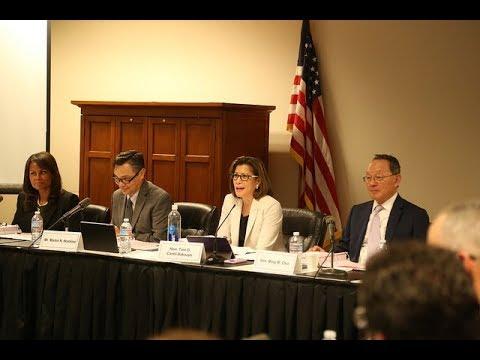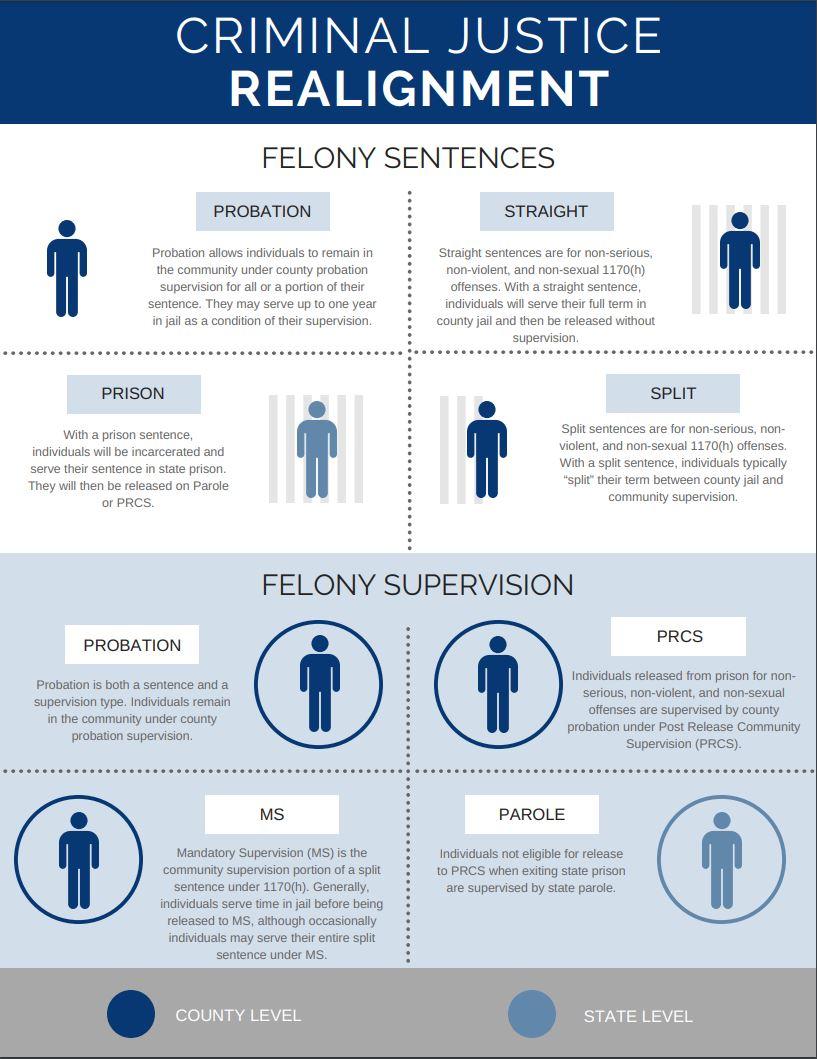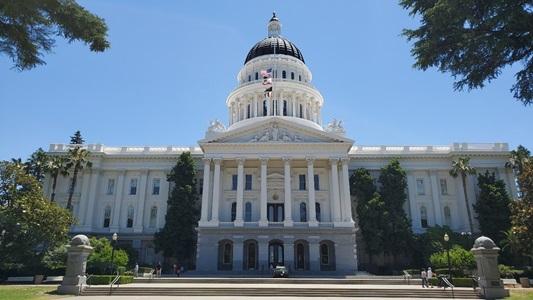Past Criminal Justice Programs
Pretrial Pilot Program
Program Overview and Purpose
The Budget Act of 2019 earmarked $75 million to the Judicial Council to launch and evaluate three-year pretrial projects in local trial courts. As directed by the Legislature, the projects aimed to increase the safe and efficient release of arrestees before trial; use the least restrictive monitoring practices possible while protecting public safety and ensuring court appearances; validate and expand the use of risk assessment tools; and assess any bias.
On August 9, 2019, the Judicial Council awarded funds to 16 pretrial projects in trial courts throughout the state.
Click here to learn more about the funded pilot programs.
Pilot Projects
Large Court Category
- Alameda
- Los Angeles
- Sacramento
Medium Court Category
- San Joaquin
- San Mateo
- San Barbara
- Sonoma
- Tulare
- Ventura
Medium/Small Court Category
- Kings
- Napa
- Nevada-Sierra
Small Courts Category
- Calaveras
- Modoc
- Tuolumne
- Yuba
Pilot Projects Map
Map of Pretrial Projects by Court Size
Quick Links
Pretrial Pilot Program Leg Report, July 2022
Pretrial Pilot Program Leg Report, January 2021
Pretrial Pilot Program Leg Report, July 2020
Pretrial Pilot Program Leg Report, January 2020
Related Links
- August 9, 2019 Judicial Council Report
- Archived Meeting Webcast
- Chief Justice Names Group to Review Pretrial Reform Efforts in California (January 15, 2019)
Pretrial Pilot Program Request for Applications (RFA) Process
The Request for Applications (RFA) was made available to the courts on May 20, 2019. It included the program goals, scope, eligibility requirements, suggested funding allocations based on court size, and scoring methodology, among other information.
Request for Applications with all Attachments (PDF Portfolio)
Individual Documents:
- Request for Applications Overview and Application
- Attachment A: Notice of Intent to Apply for Pretrial Pilot Funding and Dates for Mandatory Justice System Partner Interviews
- Attachment B: Pretrial Pilot Program Funding Project Application
- Attachment C: Budget Detail Worksheet and Narrative
- Attachment D: Pretrial Pilot Program Data Elements Inventory
- Attachment E: Pretrial Pilot Program Schedule of Deliverables
- Attachment F: Sample Quarterly Report
Frequently Asked Questions Regarding the RFA:
Judicial Council staff held an optional conference call for court applicants on June 5, 2019, to address questions related to the application process, policy, and/or scope of the pilot program. Written responses were updated weekly as additional questions were submitted.
Updated June 21: Frequently Asked Questions re: Application
After reviewing the applicants, funds were awarded to 16 pretrial projects in trial courts throughout the state on August 9, 2019. See the Pretrial Pilot Program section for details on these pilot projects.
Pretrial Detention Reform
Pretrial Detention Reform Workgroup
Purpose: Study current pretrial detention practices and provide recommendations for potential reforms.
Date Established: October 2016
Now Available: Pretrial Detention Reform Report
Read the Pretrial Detention Reform Workgroup recommendations published October 2017. Learn more about the report from the press release, Chief Justice Workgroup: Money Bail is "Unsafe and Unfair".
About

Significant attention is focused on pretrial detention throughout the country. Courts, counties, and municipalities have been the subject of multiple lawsuits asserting constitutional violations. Chief Justice Tani Cantil-Sakauye expressed concerns about individuals who are detained pretrial solely because they are too poor to afford bail in her 2016 State of the Judiciary address to the California Legislature. Members in both houses of the California Legislature have introduced legislation aimed at pretrial reform.
A Brief Guide to the California Chief Justice’s Pretrial Detention Reform Workgroup
The workgroup began its work in December 2016 and will conclude in December 2017. The recommendations will be presented to the Chief Justice for her consideration and will later be shared with Judicial Council advisory committees, as appropriate.
The recommendations may include changes to rules of court or California law, best practices for courts and justice system partners, or suggestions for related areas in need of study. The group will receive input from state and national experts, justice system partners, regulators, victim and civil liberty advocates, and states and localities that have recently undergone pretrial reform efforts.
Guiding Principles
Judicial decision-making is integral to pretrial detention. The workgroup is guided by the following principles:
- Pretrial custody should not occur solely because a defendant cannot afford bail
- Public safety is a fundamental consideration in pretrial detention decisions
- Defendants should be released from pretrial custody as early as possible based on an assessment of the risk to public safety and the risk of failing to appear in court
- Mitigating the impacts of implicit bias on pretrial release decision-making should be considered
- Reform recommendations should consider Court and justice system partner resources
- Non-financial release alternatives should be available
- Establish consistent and feasible practices for making pretrial release, detention, and supervision decisions
Members
- Hon. Brian J. Back, Co-Chair, Judge of the Superior Court of California County of Ventura
- Hon. Lisa R. Rodriguez, Co-Chair, Judge of the Superior Court of California, County of San Diego
- Hon. Mark Boessenecker, Presiding Judge of the Superior Court of California, County of Napa
- Mr. Alex Calvo, Court Executive Officer, Superior Court of California, County of Santa Cruz
- Hon. Arturo Castro, Judge of the Superior Court of California, County of Alameda
- Hon. Hilary A. Chittick, Judge of the Superior Court of California, County of Fresno
- Hon. George C. Eskin (Ret.), Retired Judge of the Superior Court of California, County of Santa Barbara
- Hon. Scott M. Gordon, Judge of the Superior Court of California, County of Los Angeles
- Hon. Teri L. Jackson, Presiding Judge of the Superior Court of California, County of San Francisco
- Hon. Brian L. McCabe,Judge of the Superior Court of California, County of Merced
- Hon. Serena R. Murillo, Judge of the Superior Court of California, County of Los Angeles
- Hon. Risë Jones Pichon, Judge of the Superior Court of California, County of Santa Clara
Proposition 57: The Public Safety and Rehabilitation Act of 2016
Effective November 9, 2016 Proposition 57 changed the law governing parole and the granting of custody credits to persons in state prison, as well as the law governing determinations of whether juveniles may be tried as adults. This memorandum provides an explanation of the proposition.
Proposition 47: The Safe Neighborhood and Schools Act
Overview
Proposition 47 implemented three broad changes to felony sentencing laws. First, it reclassified certain theft and drug possession offenses from felonies to misdemeanors. Second, it authorized defendants currently serving sentences for felony offenses that would have qualified as misdemeanors under the proposition to petition courts for resentencing under the new misdemeanor provisions. Third, it authorize defendants who have completed their sentences for felony convictions that would have qualified as misdemeanors under the proposition to apply to reclassify those convictions to misdemeanors.
Felony convictions resentenced or reclassified as misdemeanors under the proposition are considered misdemeanors for all purposes, except that such relief does not permit the person to own, possess, or have in his or her custody or control any firearm.
Early Impacts of Proposition 47 on the Courts
California superior courts received more than 200,000 petitions for resentencing or applications for reclassification during the first 13 months after voters approved Proposition 47. A report prepared by Judicial Council staff, highlights the impacts of the ballot measure on the courts during the first year of implementation.
For more information: Data Dashboards: Trends in Felony Court Case Processing
Reclassification of Theft and Drug Possession Offenses
Theft Offenses
Proposition 47 created new misdemeanors and reclassified several felony theft offenses as misdemeanors. The new misdemeanor provisions do not apply to persons with one or more prior convictions for offenses under Penal Code section 667(e)(2)(C)(iv) or for sex offenses that require registration under Penal Code section 290(c). The new provisions include:
- Shoplifting. The proposition added Penal Code section 459.5 to create a new misdemeanor offense called "shoplifting," punishable by up to 6 months in county jail. Shoplifting would be defined as "entering a commercial establishment with intent to commit larceny while that establishment is open during regular business hours" where the value of the property does not exceed $950. Any other entry into a commercial establishment with intent to commit larceny is burglary. Any act of shoplifting as defined above must be charged as shoplifting. No person charged with shoplifting may also be charged with burglary or theft of the same property.
- Forgery. Before Proposition 47, forgery under Penal Code section 473 was a wobbler offense. Proposition 47 reclassified forgery of specified instruments involving $950 or less as exclusively a misdemeanor. The misdemeanor provision is not applicable to any person convicted both of forgery and identity theft under Penal Code section 530.5.
- Insufficient Funds. Before Proposition 47, a violation of Penal Code section 476a was a wobbler offense, except that the offense was strictly a misdemeanor if the total underlying amount did not exceed $450, unless the person was previously convicted of one of several specified theft offenses. Proposition 47 increased the total threshold amount for misdemeanors from $450 to $950 and increased the number of disqualifying prior convictions from one to "three or more."
- Petty Theft. Proposition 47 added Penal Code section 490.2 to expressly define petty theft as “obtaining any property by theft where the value of the money, labor, real or personal property taken” does not exceed $950. This new definition of petty theft applies notwithstanding Section 487 “or any other provision of law defining grand theft.” (Pen. Code, § 490.2(a).) As such, the new definition of petty theft appears to apply regardless of how specific categories of property are treated under separate statutes. This new provision is not applicable to any theft that may be charged as an infraction “pursuant to any other provision of law.”
- Receiving Stolen Property. Before Proposition 47, a violation of Penal Code section 496 was a wobbler offense, except that if the value of the property did not exceed $950, the district attorney or grand jury could specify the offense as exclusively a misdemeanor “in the interests of justice.” Proposition 4 7 rendered all violations of section 496 that do not exceed $950 as strictly misdemeanors, eliminating prosecutorial discretion to charge those offenses as felonies.
- Petty Theft with a Prior. For most defendants, Proposition 47 eliminated the offense of petty theft with a prior under Penal Code section 666 by narrowing the category of persons subject to punishment under that section to only include persons required to register under the Sex Offender Registration Act, persons with prior violent or serious felony convictions under section 667.5(e)(2)(C)(iv), and persons convicted of Penal Code section 368(d) or (e) [specified theft crimes involving elder or dependent adults].
Drug Possession Offenses
Proposition 47 also reclassified drug possession offenses under Health and Safety Code sections 11350, 11357(a) [concentrated cannabis], and 11377 as strictly misdemeanors punishable by up to one year in county jail. As with the theft offenses, these new misdemeanor provisions do not apply to persons with one or more prior convictions for offenses specified under Penal Code section 667(e)(2)(C)(iv) or for a sex offense that requires registration under Penal Code section 290(c).
Resentencing
Eligibility
Proposition 47 added Penal Code section 1170.18 to authorize persons currently serving sentences for felony convictions that are now misdemeanors under the proposition to petition courts for recalls of sentences and to request resentencing under the new laws (Pen. Code § 1170.18(a).), except that persons with one or more prior convictions for offenses listed under section 667(e)(2)(C)(iv) or for a sex offense that requires registration under section 290(c) are not eligible for resentencing. (Pen. Code, § 1170. l 8(i).)
Petitions
Petitions for resentencing must have been filed by November 4, 2022, “or at a later date upon a showing of good cause.” (Pen. Code § 1170.18(j).) Petitions must be filed with the trial court that entered the original judgment unless that judge is unavailable, in which case the presiding judge must designate another judge to rule on the petition. (Pen. Code, § 1170.18(a), (1).)
Resentencing Considerations
If the court determines that the petitioner is eligible for resentencing, the court must recall the sentence and resentence the petitioner under the new misdemeanor provisions “unless the court, in its discretion, determines that resentencing the petitioner would pose an unreasonable risk of danger to public safety.” (Pen. Code, § 1170. l18(b).) The phrase “unreasonable risk of danger to public safety” is defined narrowly as an unreasonable risk that the petitioner will commit a new violent felony within the meaning of section 667(e)(2)(C)(iv). (Pen. Code, § 11l70.18(c).) Persons who are resentenced must be given credit for time served and are subject to a period of parole for one year under section 3000.08 “unless the court, in its discretion, as part of its resentencing order, releases the person from parole.” (Pen. Code, § 1170.18(d).) Resentencing may not result in the imposition of a term that is longer than the original sentence. (Pen. Code, § 1170.18(e).) A resentencing hearing is considered a “post-conviction release proceeding” under Article I, Section 28(b)(7) of the California Constitution (Marsy's Law).
Reclassifying Convictions
Proposition 47 also authorizes persons who have completed their sentences for felony offenses that would have qualified as misdemeanors under the new laws to apply for a reduction of their felony conviction to a misdemeanor. (Pen. Code, § 1l170. l18(f).) Persons with one or more prior convictions for offenses listed under section 667(e)(2)(C)(iv) or for a sex offense that requires registration under section 290(c) are not eligible for reclassification. (Pen. Code, § 1170.18(i).) As with the resentencing provisions explained above, applications for reclassification must be made with the trial court that entered the original judgment unless that judge is unavailable, in which case the presiding judge must designate another judge to rule on the petition. (Pen. Code § 1170.18(f), (1).) All applications must be filed by November 4, 2022, “or at a later date upon a showing of good cause.” (Pen. Code, § 1170.l18(j).) If the court determines that the person is eligible for reduction, the court must designate the felony offense as a misdemeanor. (Pen. Code, § 1170.l18(g).) Unlike the resentencing provisions under section 1170.18(a), reductions to misdemeanors do not hinge on considerations of an “unreasonable risk of danger to public safety.” Unless requested by the applicant, no hearing is necessary to grant or deny an application. (Pen. Code, § 1170.18(hf).)
Proposition 47 Filings: November 2014 – December 2023 (Updated March 2024)
Proposition 47 FAQs (Updated November 2016)
Memorandum on Proposition 47 (May 2016)
Recidivism Reduction Fund Court Grant Program
Program Overview and Purpose
As part of the Budget Act of 2014, the Legislature allocated $15 million from the Recidivism Reduction Fund (RRF) for a competitive grant program to be administered by the Judicial Council of California. The funds were designated for courts to use in the administration and operation of programs and practices known to reduce offender recidivism and enhance public safety, including the use of validated risk and needs assessments, other evidence-based practices, and programs that specifically address the needs of mentally ill and drug-addicted offenders.
Recidivism Reduction Funds supported the operation of 20 collaborative courts and 11 pretrial programs. RRF funding also provided an opportunity, in FY 2015-16, for 8 courts to conduct local training and technical assistance programs related to recidivism reduction.
Map of California RRF grant awards With three rounds of grants made in April, July and November of 2015, a total of 36 courts and their criminal justice partners operated Recidivism Reduction Fund projects in either the pretrial or collaborative courts category and/or received training and technical assistance.
Summary of RRF Awards
Recidivism Reduction Fund Resources
- RRF Annual Report 2019
- RRF Annual Report 2018
- RRF Annual Report 2017
- RRF Annual Report 2016
- May 28, 2015 Webinar Presentation
- RRF Budget Form: Ongoing Program Operations Costs
- Program Progress Report: Quarterly Grant Administration & Tracking Report
Reentry Courts
What is a reentry court?
In California, a reentry court is a type of collaborative justice court for individuals who have been released from prison, have violated their terms of community supervision, and have a history of substance abuse or mental health issues.
How do reentry courts work?
Although reentry courts operate slightly different across counties, the following program components are common to reentry courts in California.
- The reentry court team makes decisions about a participant’s court case. Reentry court teams are led by the judge and usually includes a defense attorney, a prosecutor, a parole agent, a probation officer, and treatment staff and/or case managers.
- Reentry court participants are assessed for their risk of re-offending and treatment needs. This information is used to create supervision and treatment plans.
- The program connects participants to a variety of supports including mental health treatment, substance use treatment, and housing.
- Participants attend scheduled court sessions usually one to four times a month to discuss their progress.
- The court can recommend early discharge from community supervision when a participant successfully completes the program. Participants usually stay in the program for approximately 12-18 months.
Select from the below links for information on existing programs, eligibility requirements, history, and resources.
2016 Reentry Court Roundtable
The one-day session convened judges, probation and parole officers, service providers and criminal justice partners to explore lessons learned, differences between parole and probation, evaluation and research as well as strengthening partnerships.
Materials and Resources
The resources and materials distributed during and after the “Reentry Court Roundtable” are included here for your use. It includes articles, faculty PowerPoint presentations, model court documents and forms, information covering funding services and programs and a roster of attendees
Additionally, we have attached a Department of Health Care Services flier, which answers frequently asked questions, defines case management services, and who might be eligible to, in limited circumstances, receive payment for providing those services.
2014 Reentry Court Summit
Click here to view the agenda and faculty materials for the event.
A Reentry Court Summit titled "Court Programs and Practices for Working with Reentry, PRCS, and Mandatory Supervision Populations" was held on APRIL 21, 2014 in San Francisco, CA at the offices of the Judicial Council. Invitations were sent to existing programs and to courts interested in starting up a reentry court program.
Topics covered included:
- Parolee Reentry Courts
- Reentry Courts for the Mandatory Supervision and PRCS populations
- Affordable Care Act
- Harlem Reentry Court: National Prospective
- Innovative Programs that Serve Reentry Populations
- Probation and Parole Staff
- Service Providers
Quick Links
- Parolee Reentry Court Program Evaluation: Final Report (December 2014)
California's Three Strikes Sentencing Law (Prop 36)
California's Three Strikes sentencing law was originally enacted in 1994. The essence of the Three Strikes law was to require a defendant convicted of any new felony, having suffered one prior conviction of a serious felony to be sentenced to state prison for twice the term otherwise provided for the crime. If the defendant was convicted of any felony with two or more prior strikes, the law mandated a state prison term of at least 25 years to life.
On November 6, 2012 the voters approved Proposition 36 which substantially amended the law with two primary provisions:
- The requirements for sentencing a defendant as a third strike offender were changed to 25 years to life by requiring the new felony to be a serious or violent felony with two or more prior strikes to qualify for the 25 year-to-life sentence as a third strike offender; and
- The addition of a means by which designated defendants currently serving a third strike sentence may petition the court for reduction of their term to a second strike sentence, if they would have been eligible for second strike sentencing under the new law.
Materials:
The Amendment of the Three Strikes Sentencing Law (May 2017) by J. Richard Couzens, Judge of the Superior Court of Placer County (Ret.) and Presiding Justice Tricia A. Bigelow, Court of Appeal, 2nd Appellate District, Div. 8
Video: Prop 36 Amendments to California's Three-Strikes Sentencing
|
Playlist Index: Part 1: Introduction Part 2: Use of a Firearm Part 3: Prior Offenses Part 4: Consecutive Sentencing Part 5: Petitioning for Resentencing Part 6: Multiple Counts Part 7: Qualification Hearing Part 8: Court's Discretion Part 9: Pleadings and Retrial Part 10: Order of the Court view the full video (54:57) |
Evidence-Based Practice
Perhaps the most important reform in state sentencing and corrections practice taking place today is the incorporation of principles of evidence-based practice into state sentencing and corrections policy and practice.
The term evidence-based practice (EBP) was used initially in relation to medicine, but has since been adopted by many fields including education, child welfare, mental health, and criminal justice.
EBP refers to outcome-focused approaches and interventions that have been scientifically tested in controlled studies and proven effective. EBP implies that there is a definable outcome(s), which are measurable and are defined according to practical realities (recidivism, victim satisfaction, etc.).
Interventions within corrections are considered effective when they reduce offender risk and subsequent recidivism. (Note - recidivism can be defined in many ways, i.e., re-arrest, re-conviction, parole revocation, return to incarceration, return to prison.) When offender risk is reduced, there are fewer victims of crime and public safety is enhanced.
Listed below are the commonly used Evidence-Based Principles for Community Corrections:
- Assess Actuarial Risk/Needs.
- Enhance Intrinsic Motivation.
- Target Interventions.
- Risk Principle: Prioritize supervision and treatment resources for higher risk offenders.
- Need Principle: Target interventions to criminogenic needs.
- Responsivity Principle: Be responsive to temperament, learning style, motivation, culture, and gender when assigning programs.
- Dosage: Structure 40-70% of high-risk offenders' time for 3-9 months.
- Treatment: Integrate treatment into the full sentence/sanction requirements.
- Skill Train with Directed Practice (use Cognitive Behavioral treatment methods).
- Increase Positive Reinforcement.
- Engage Ongoing Support in Natural Communities.
- Measure Relevant Processes/Practices.
- Provide Measurement Feedback.
Risk/Needs Assessment Actuarial risk assessment instruments have been shown to be more accurate than even the best clinical judgment in determining offender risk. Unfortunately, only a few state judges and courts in the United States have experience in using risk/needs assessment information in sentencing offenders or responding to violations of parole.
Use of risk and needs assessment information is critical in making evidence- based judicial determinations of important recurring sentencing issues, such as:
- Offender's suitability for diversion;
- Most appropriate conditions of probation to be imposed;
- Offender's amenability to treatment;
- Most appropriate treatment or level of supervision to be imposed;
- Most appropriate sanction or behavioral control mechanism to be imposed;
- Kind of sanction, incentive or additional service to be ordered upon a violation of probation; and
- Whether or when to revoke probation.
In the recent Indiana Supreme Court decision in the case of Malenchik v. State of Indiana, the court observed that "the concept of evidence-based sentencing practices has considerable promise for the goal of reduced offender recidivism and improvement of sentencing outcomes."
The California Risk Assessment Pilot Project (CalRAPP)
CalRAPP Final Report The California Risk Assessment Pilot Project: The Use of Risk and Needs Assessment Information in Adult Felony Probation Sentencing and Violation Proceedings, December 2015
The California Risk Assessment Pilot Project (CalRAPP) began in 2009 as a joint project of the Judicial Council of California (JCC) and the Chief Probation Officers of California, and is funded by the National Institute of Corrections and the State Justice Institute.
This pilot project, which took place in four California counties (i.e., Napa, San Francisco, Santa Cruz, and Yolo), focused on evidence-based practices and the ways in which risk and needs assessment (RNA) information can be incorporated into adult felony probation sentencing and violation proceedings. Some highlighted findings include:
- Probation departments in the pilot sites sentenced a significantly lower proportion of adult felony probationers to prison and jail compared to probation departments in the rest of the state; and
- Individual-level findings support the predictive validity of the RNA tools utilized by the pilot sites as tools that are able to predict the occurrence of future noncompliant behavior.



